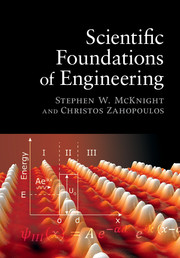Book contents
- Frontmatter
- Contents
- Introduction
- 1 Kinematics and vectors
- 2 Newton's Laws, energy, and momentum
- 3 Rotational motion
- 4 Rotation matrices
- 5 Materials properties: elasticity
- 6 Harmonic oscillation
- 7 Waves
- 8 The quantum puzzle
- 9 Quantum mechanics
- 10 Quantum electrons in atoms, molecules, and materials
- 11 Quantum electrons in solids
- 12 Thermal physics: energy, heat, and thermodynamics
- 13 Quantum statistics
- 14 Maxwell's equations and electromagnetism
- 15 Electromagnetic waves
- 16 Electromagnetic materials
- 17 Fluids
- Bibliography
- Index
2 - Newton's Laws, energy, and momentum
Published online by Cambridge University Press: 05 September 2015
- Frontmatter
- Contents
- Introduction
- 1 Kinematics and vectors
- 2 Newton's Laws, energy, and momentum
- 3 Rotational motion
- 4 Rotation matrices
- 5 Materials properties: elasticity
- 6 Harmonic oscillation
- 7 Waves
- 8 The quantum puzzle
- 9 Quantum mechanics
- 10 Quantum electrons in atoms, molecules, and materials
- 11 Quantum electrons in solids
- 12 Thermal physics: energy, heat, and thermodynamics
- 13 Quantum statistics
- 14 Maxwell's equations and electromagnetism
- 15 Electromagnetic waves
- 16 Electromagnetic materials
- 17 Fluids
- Bibliography
- Index
Summary
We spend most of our life in a world of macroscopic objects moving and interacting, yet many – perhaps most – people can't describe correctly the trajectory of an object thrown from a moving car. We are aware there are rules that govern motion and interactions, but what they are, when they apply, and how they can be applied to predict the motion of a pool cue ball after it collides with an object ball, for example, are a mystery to most people, judging by how often casual pool players “scratch” by pocketing the cue ball. Even engineers, who have all had at least a year-long course in physics, are often uneasy when they are asked what exactly Newton's Laws mean instead of just reciting the words. As a matter of fact, the vast majority of people are still Aristotelian thinkers in their understanding of the laws that govern motion. In this chapter we will revisit these fundamental concepts with the goal of increasing the level of comfort with the concepts of forces and motion. Newton's Laws
The traditional formulation of Newton's Laws is something like these below:
First Law: An object at rest tends to remain at rest and an object in motion tends to remain in uniform motion (in a straight line at a constant speed) unless acted upon by a net force.
Second Law: An object of mass m acted upon by a net force F experiences constant acceleration a according to the formula F = ma.
Third Law: Every action has an equal and opposite reaction.
These statements are a combination of definitions and empirical (“determined by observation”) laws. For example, a force (F) is often described as a “push or pull that, if acting alone on a body, causes a constant acceleration.” This is a circular definition that makes the Second Law a meaningless statement. The First Law also has conditions on it: you can't be in an accelerating or rotating system.
- Type
- Chapter
- Information
- Scientific Foundations of Engineering , pp. 19 - 38Publisher: Cambridge University PressPrint publication year: 2015



